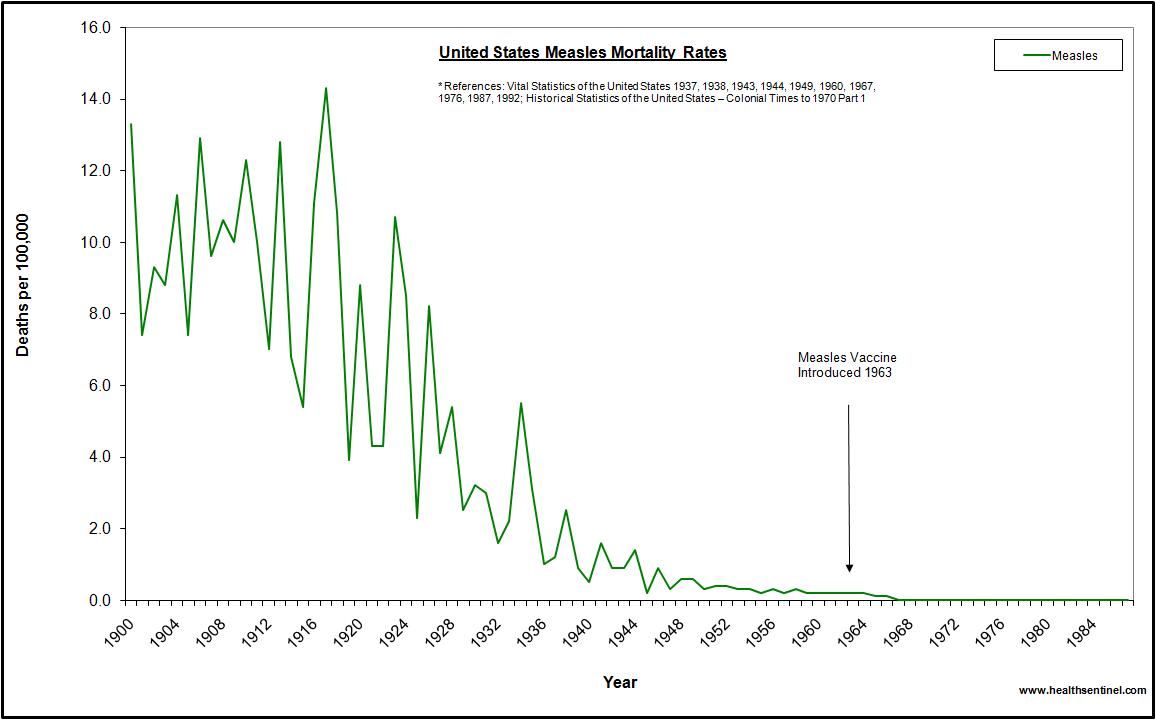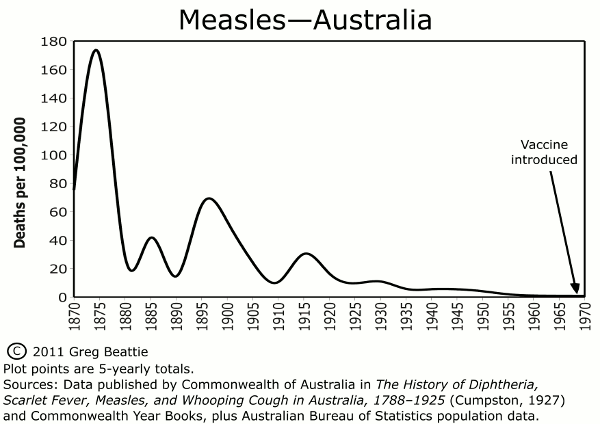Towards the end of last year, I said I was not going to write any more controversial / semi-political newsletters, as the covid “crisis” wound down. I meant it at the time. However, I was inundated with emails from customers and well-wishers asking me to keep going (although there were around 1% who wrote to me telling me to shut up, and that I wasn’t even entitled to have an opinion). Anyway, in this newsletter, I am writing for the 99% of my audience who said that they want to know more about what I have to say.
Today, I am going to pose a question. If there were two traditional vaccinations, where I could show you strong evidence that the claim that they were effective is in essence based on a lie, would you trust anything else you were told about other vaccinations? That’s one I’ll let you ponder on, after considering the following : –
Measles Vaccine
The measles vaccine was introduced in the UK in 1968, but it only became widely administered in the early 1980’s. The claim has always been that it saved and is still saving many lives. Below are the stats on the effect it actually had on infant mortality from 1838 to the late 1970’s in the UK. Bare in mind that this graph only goes up to 1978, when the takeup was very low.

I know it’s rather hard to see, so below I will blow up the salient bits as much as I can. Here is what the arrow on the far right shows. (The other two annotations shown with arrows just show the words “data gap)”.
As you can see, there is very little evidence that the vaccine saved lives because by the time it came along nobody was dying from measles. I had measles myself as a kid, and I remember it pretty well. It was mild flu with very itchy spots, and it got me a week off school, which I was pretty pleased about at the time. Being the generous young man I was, I passed it on to my brother, who also got the week off school. It was not a deadly disease. In fact as kids in the 70’s we all got measles and we all lived to tell the tale. If you’re a millennial, just ask your parents if you don’t believe me.
In case you’re wondering where these rates stats shown in the graphs above come from, I’ll blow that up too.
You’d probably say, well the UK’s only one country. I agree. So let’s look at the USA, who introduced the vaccine a few years before us, in 1963. That’s the country who’s current President said he was “losing patience” with people who did not want to have a similar medical procedure in 2021 and 2022.

Well, that’s only two countries. So let’s look at Australia. That’s the country which went a step further than that nice Mr Biden. They were actually kidnapping children from their parents, contrary to parental consent, in order to force their children to have the same medical procedure in 2021-2022, as discussed here. Anyway, I digress. Below are the deaths per 100,000 in Australia from measles from 1870 to 1970, showing the “amazing success” of the measles vaccination.

Doubtless the vaccinations were very profitable for the manufacturers. But I do not believe that they dealt with the real cause. The real causes of death from measles were poverty, poor hygiene, and disgusting living conditions. The real thing that stopped the deaths was ending poverty, improving hygiene, and improving living conditions. It had nothing to do with plunging toxic chemicals into our children’s bloodstreams. I think the examples above make the case clear.
* The graphs above come from the book Dissolving Illusions by Dr Suzanne Humphries M.D. Highly recommended!
Diptheria Vaccine
Few people talk about diptheria any more. But this is one that has been of interest to me for 35 years, as I will explain. The vaccination against diptheria is one of those that “everyone knows” cured diphtheria, and is one they can point to “prove” their case. Unfortunately, there is one rather fundamental weakness to this argument. Which is that the claim is actually nonsense, and the UK report proving this was buried by our own government.
As it happens, my late father had a report in his possession which proved the opposite to be the case. Who did the study proving that it wasn’t true? The UK government sponsored Medical Research Council, paid for by the UK taxpayer. Regrettably my father’s girlfriend threw out his wonderful library of pioneering health and naturopathic books, reports, lectures etc going back over one hundred years in the later years of his life, before I had the chance to rescue them, otherwise I would have provided actual screen shots of the original report. I tremendously doubt whether many people possess this important historical document today, which is a real pity.
Fortunately, a good summary of the report is cited in the book ‘Vaccination And Immunisation: Dangers, Delusions and Alternatives (What Every Parent Should Know)’, a book written in the 1980’s by Leon Chaitow, which do I have at home. Back in the 80’s and 90’s, Chaitow was probably the most well known naturopath in the country and occasionally gave lectures at the British College of Naturopathy and Osteopathy, where I was part-trained. Because I am one of the few people alive who has read the original report, I can confirm that the following text is accurate. Please note my own comments are added in red, and a few key points have been made bold.
The fallacy of the assumption that antibody formation is a measure of immunity was fully demonstrated in a report issued by the Medical Research Council in May 1950, entitled ‘A Study of Diphtheria in Two Areas of Great Britain”. In this report by nine doctors (Percival Hartley, W. J. Tulloch, M. Ander- son, W. A. Davidson, J. Grant, W. M. Jamieson, C. Kenbarrer, R. Morton, and G. H. Robertson), it was stated that the occurrence of diphtheria in the inoculated “led to the investigation into the immunity state, and the behaviour of the immunity mechanism”.
‘In view of the extreme importance of this question, and because so many tests with various vaccines are likely to be made, both in this country and in others, in which it is taken for granted (even if it’s not true) that the antibody formation can be correlated with immunity, it seems desirable to give a brief resumé of the Medical Research Council’s findings.
‘It appears that in the course of the study conducted by these nine doctors, inquiry was made into “clinical diphtheria in 95 fully inoculated persons in Newcastle and Gateshead, with special reference to the antitoxin concentration of the serum of these persons, and of hospital nurses, familial contacts, and carriers”,
There had already, it is stated, been an investigation in 1939 and in 1940-42 of “The antitoxin concentration of the serum of 62 inoculated persons who contracted diphtheria in different areas in England and Wales” but in the first period of the investigation: “Some of the results obtained were so unusual and unexpected, so contradictory, and indeed paradoxical that the inquiry as originally envisaged and put into effect had to be brought to a close”.
“The paradox” they said, was this:on repeated occasions it was found that a sample of serum, taken from patient with a clear history of inoculation who had yielded diphtheria bacilli from nose or throat swabs,and who according to the clinical history exhibited some or other of the classical symptoms of true diphtheria, was found to contain quite large quantities of diphtheria antitoxin.
In other words, the vaccination didn’t work.
Now according to Schick, persons whose serum contains not less than one-thirtieth of a unit of antitoxin per ml. or, according to workers in this and other countries not less than one-hundredth of a unit of antitoxin per ml should not contract diphtheria. Yet of 62 of the patients investigated prior to April 1942, no less than 25 (40 per cent) were found to contain one-tenth of a unit, or more of diphtheria antitoxin per ml. of serum, and of these 5 contained 10 units or more, 7 contained 1-4 units and 13 contained 0.1-0.8 units per ml. of serum (demonstrating that the vaccination didn’t work).
‘In explanation of this it was suggested that a mistake had been madesomewhere (because they would not accept that the vaccination didn’t work) but ‘critical examination of the procedures used for the determination of the antitoxin content of samples of blood and serum failed to reveal sources of error which could account for the high titres”.
They therefore decided to renew the investigation of Tyneside and to take the greatest possible care in the selection of patients and collection of pathological material and in its examination. But still they found as many as 30 persons with clinical diphtheria, in whom the antitoxin content of the serum was one-twentieth of a unit, or more per ml. (demonstrating for a second time that the vaccination didn’t work).
They encountered another paradox, “namely, the occurrence of several instances of non-inoculated persons having no circulating antitoxin, harbouring virulent organisms, and yet remaining perfectly well, of nurses with little or no circulating antitoxin, regularly employed in diphtheria wards and remaining free from diphtheria; of persons previously inoculated or not, with little or no circulating antitoxin, living in intimate contact with diphtheria in their homes, and yet remaining perfectly well. It was confidently expected that cases of diphtheria would arise, either among the nurses, or among the real relations of patients, and thus provide the material for this part of the inquiry, but this expectation did not materialise (demonstrating that vaccination did not prevent diptheria. It was prevented by having robust pre-existing immunity).
‘Part IlI of the Report deals with the diphtheria outbreak in Dundee, 1941-2, and here there is also a reference to the occurrence of diphtheria in persons whose serum contained an appreciable amount of antitoxin. (In other words, the vaccination didn’t work in 1942 either). The facts disclosed in this Report proved the fallacy of the theory that the presence of antibodies in the blood shows protection against a particular disease; but in all the reports recently published, regarding the testing of immunity [against poliomyelitis infection], they appear to have been conveniently ignored, and the assumption made that the theory is firmly established.
So, the best they could come up with what that “a mistake had been madesomewhere” instead of accepting the obvious conclusion, which is that the vaccination did not work. Personally, I can’t help wondering whether the authors were paid off by the manufacturer to “not notice”, or whether they were just so rigid in their thinking that they were incapable of accepting the truth, even when it was hitting them in the face.
However Leon Chaitow did not refer to the most astonishing part of the report. Because my father’s copy was thrown away, I don’t have the precise words in front of me. But I remember what it said, more or less. It was something to the effect of the following (put in posh and more flowery language):
“We know that the diphtheria vaccines must work, even though our research proved that they do not, because we know that vaccinations (in general) work. The reason we know vaccinations work, is because that’s what the established science says. Therefore they work, and so does the one we are studying here. We therefore strongly advise the government (who commissioned this report) to carry on with and extend the diptheria vaccination programme, and to ignore our own report”.
And guess, what? That’s precisely what happened.
In reality, I think the main cause of death from diptheria was (and still is) poverty, poor hygiene, and disgusting living conditions. The real thing that stopped deaths was ending poverty, improving hygiene, and improving living conditions. It had nothing to do with plunging toxic chemicals and disgusting microbial remnants into our children’s bloodstreams.
In conclusion
The point here is what the two examples above, going back around 70 years, where clearly the public were and to this day still are being misled, are reminiscent of. Doesn’t this remind you of a certain more recent vaccination, which did not prevent the illness it was supposed to prevent, and did not prevent the spread of the illness it was supposed to prevent? Looking back at the examples of measles and diptheria above, do you think things have changed very much?
 I hope you find this interesting, and a welcome change from the typical commercial newsletters, designed to sell the products that companies usually send their customers. I would benefit more personally / financially by writing newsletters that promote the products and services which we provide, and that’s probably what I will get back to next time.
I hope you find this interesting, and a welcome change from the typical commercial newsletters, designed to sell the products that companies usually send their customers. I would benefit more personally / financially by writing newsletters that promote the products and services which we provide, and that’s probably what I will get back to next time.
Best wishes
Mark G. Lester
Director – The Finchley Clinic Ltd
www.thefinchleyclinic.com
